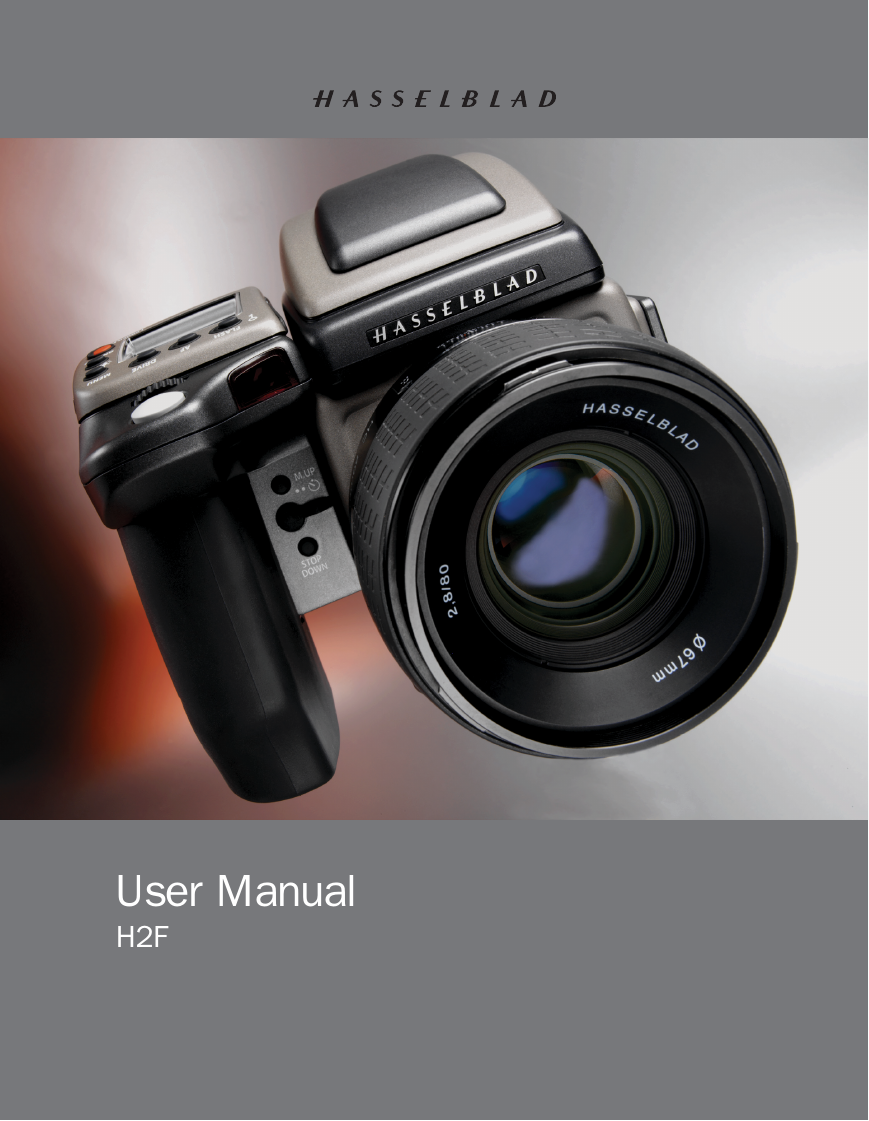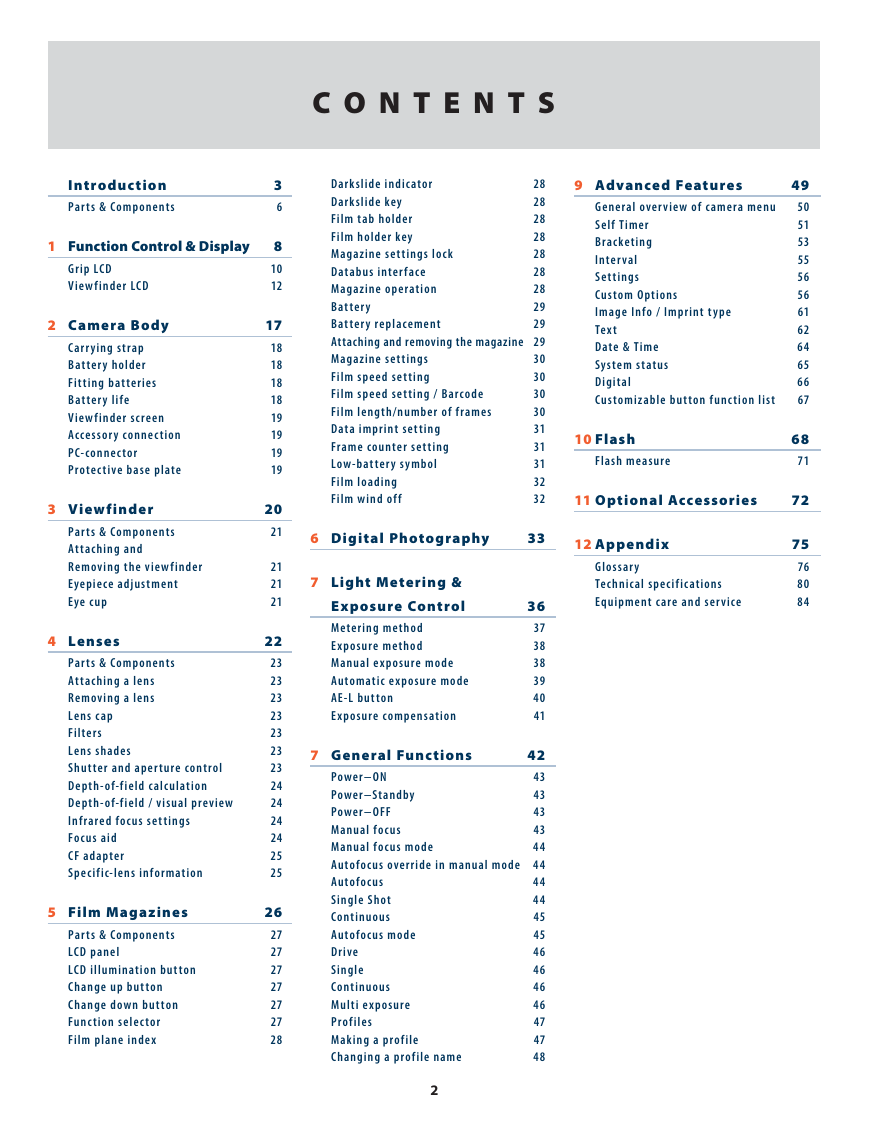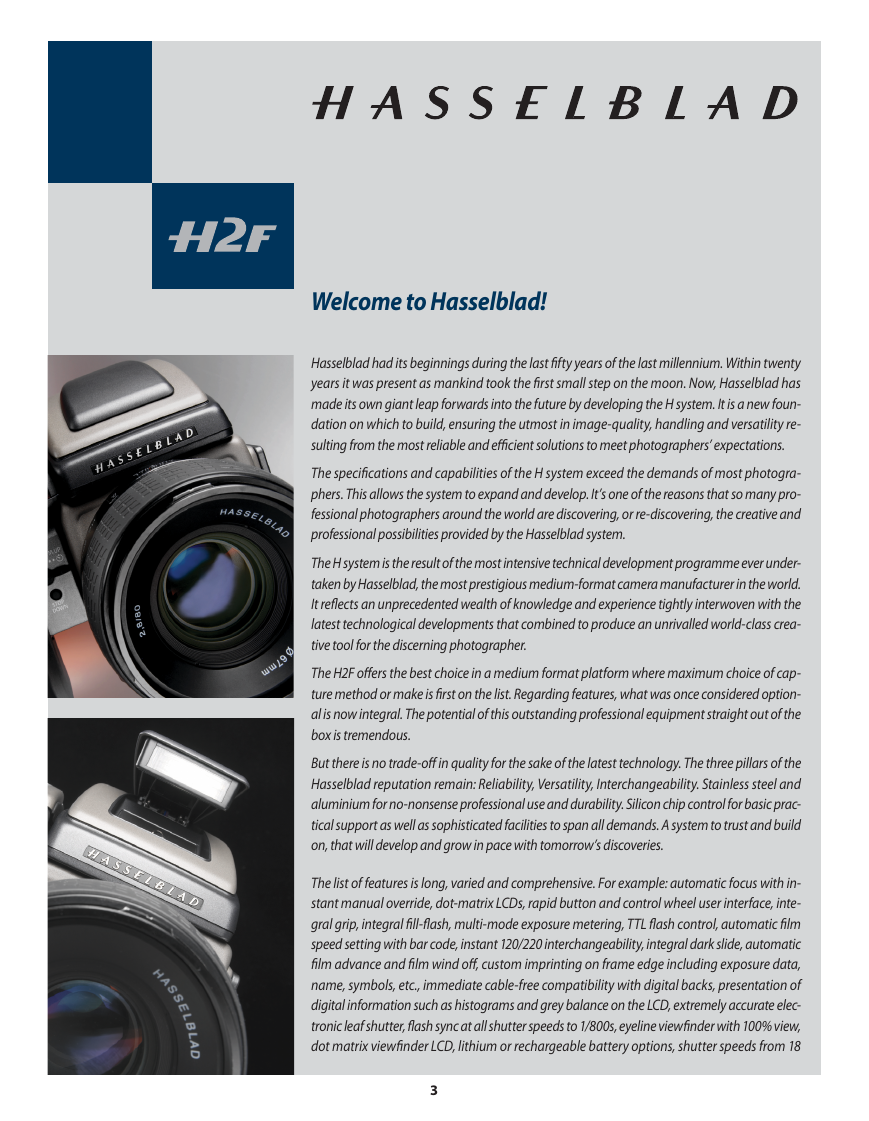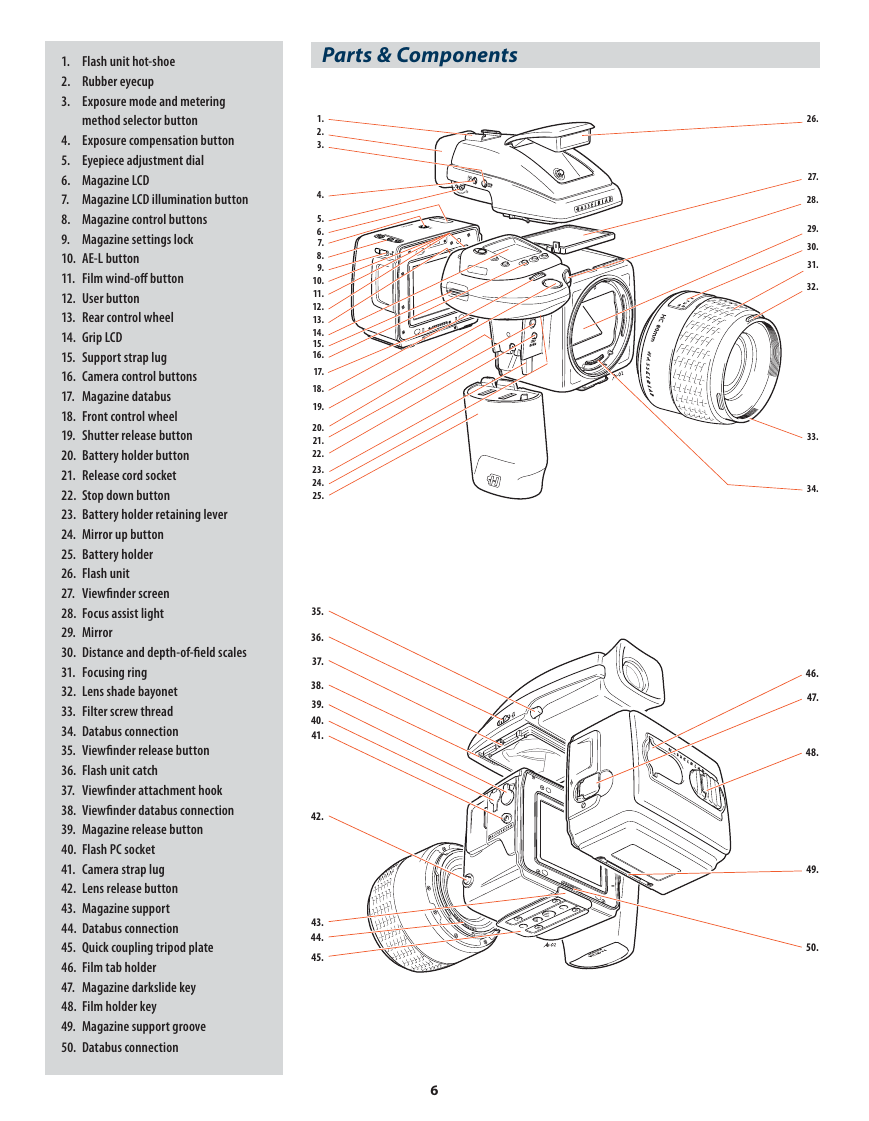User Manual
H2F
�
Introduction
Parts & Components
1 Function Control & Display
Grip LCD
Viewfinder LCD
2 Camera Body
Carrying strap
Battery holder
Fitting batteries
Battery life
Viewfinder screen
Accessory connection
PC-connector
Protective base plate
3 Viewfinder
Parts & Components
Attaching and
Removing the viewfinder
Eyepiece adjustment
Eye cup
4 Lenses
Parts & Components
Attaching a lens
Removing a lens
Lens cap
Filters
Lens shades
Shutter and aperture control
Depth-of-field calculation
Depth-of-field / visual preview
Infrared focus settings
Focus aid
CF adapter
Specific-lens information
5 Film Magazines
Parts & Components
LCD panel
LCD illumination button
Change up button
Change down button
Function selector
Film plane index
3
6
8
10
12
17
18
18
18
18
19
19
19
19
20
21
21
21
21
22
23
23
23
23
23
23
23
24
24
24
24
25
25
26
27
27
27
27
27
27
28
49
50
51
53
55
56
56
61
62
64
65
66
67
68
71
72
75
76
80
84
C O N T E N T S
28
Darkslide indicator
28
Darkslide key
28
Film tab holder
28
Film holder key
28
Magazine settings lock
28
Databus interface
28
Magazine operation
29
Battery
Battery replacement
29
Attaching and removing the magazine 29
30
Magazine settings
Film speed setting
30
30
Film speed setting / Barcode
30
Film length/number of frames
31
Data imprint setting
Frame counter setting
31
31
Low-battery symbol
32
Film loading
Film wind of f
32
9 Advanced Features
General overview of camera menu
Self Timer
Bracketing
Interval
Settings
Custom Options
Image Info / Imprint type
Text
Date & Time
System status
Digital
Customizable button function list
10 Flash
Flash measure
11 Optional Accessories
6 Digital Photography
33
12 Appendix
Glossary
Technical specifications
Equipment care and service
7 Light Metering &
36
37
38
38
39
40
41
Exposure Control
Metering method
Exposure method
Manual exposure mode
Automatic exposure mode
AE-L button
Exposure compensation
7 General Functions
42
43
Power−ON
43
Power−Standby
43
Power−OFF
43
Manual focus
Manual focus mode
44
Autofocus override in manual mode 44
Autofocus
44
44
Single Shot
45
Continuous
45
Autofocus mode
Drive
46
46
Single
46
Continuous
46
Multi exposure
Profiles
47
47
Making a profile
Changing a profile name
48
2
�
Welcome to Hasselblad!
Hasselblad had its beginnings during the last fifty years of the last millennium. Within twenty
years it was present as mankind took the first small step on the moon. Now, Hasselblad has
made its own giant leap forwards into the future by developing the H system. It is a new foun-
dation on which to build, ensuring the utmost in image-quality, handling and versatility re-
sulting from the most reliable and efficient solutions to meet photographers’ expectations.
The specifications and capabilities of the H system exceed the demands of most photogra-
phers. This allows the system to expand and develop. It’s one of the reasons that so many pro-
fessional photographers around the world are discovering, or re-discovering, the creative and
professional possibilities provided by the Hasselblad system.
The H system is the result of the most intensive technical development programme ever under-
taken by Hasselblad, the most prestigious medium-format camera manufacturer in the world.
It reflects an unprecedented wealth of knowledge and experience tightly interwoven with the
latest technological developments that combined to produce an unrivalled world-class crea-
tive tool for the discerning photographer.
The H2F offers the best choice in a medium format platform where maximum choice of cap-
ture method or make is first on the list. Regarding features, what was once considered option-
al is now integral. The potential of this outstanding professional equipment straight out of the
box is tremendous.
But there is no trade-off in quality for the sake of the latest technology. The three pillars of the
Hasselblad reputation remain: Reliability, Versatility, Interchangeability. Stainless steel and
aluminium for no-nonsense professional use and durability. Silicon chip control for basic prac-
tical support as well as sophisticated facilities to span all demands. A system to trust and build
on, that will develop and grow in pace with tomorrow’s discoveries.
The list of features is long, varied and comprehensive. For example: automatic focus with in-
stant manual override, dot-matrix LCDs, rapid button and control wheel user interface, inte-
gral grip, integral fill-flash, multi-mode exposure metering, TTL flash control, automatic film
speed setting with bar code, instant 120/220 interchangeability, integral dark slide, automatic
film advance and film wind off, custom imprinting on frame edge including exposure data,
name, symbols, etc., immediate cable-free compatibility with digital backs, presentation of
digital information such as histograms and grey balance on the LCD, extremely accurate elec-
tronic leaf shutter, flash sync at all shutter speeds to 1/800s, eyeline viewfinder with 100% view,
dot matrix viewfinder LCD, lithium or rechargeable battery options, shutter speeds from 18
3
�
hours to 1/800s, user customization of functions. And that’s not all! Bracketing, interval timer,
rapid access user button, flash measure, independent LCD illumination on magazines, integral
diopter adjustment in viewfinder, zone system capability, time-lapse photography, customized
profiles and so on.
In digital photography, the advantages of larger format cameras become particularly obvious.
The 6 x 4.5 cm window allows the Hasselblad H2F to use the largest image sensors currently
available in digital photography – more than twice the size of a 35mm camera sensor. The sen-
sor therefore holds more and larger pixels, which secure a high-end image quality in terms of
moiré free color rendering without gradation break-ups in even the finest lit surfaces.
When using a digital back you have the advantage of features such as Hasselblad Natural Color
Solution, DNG workflow, Instant Approval Architecture, “Instant” user interface, three modes of
operation and storage as well as FlexColor or Phocus software for professional level workflow.
Furthermore, apart from the practical aspects, the H2F also exudes a feeling of superb design
and ergonomics that makes the camera a pleasure to own as well as use. For handling and con-
venience of use it is second to none.
So Hasselblad, the most distinguished pioneer in medium-format photography, yet again takes
the vanguard position. We are confident that you are going to incorporate this camera insepa-
rably into your photographic life. We are also confident that you are going to produce images
you are proud of. Some of these will remain as a documentation of the history of our world,
perhaps even beyond. That’s how it is with Hasselblad.
sssssssssssssss
The primary goal of all camera development is of course the seamless and unobtrusive produc-
tion of superb images, regardless of situation. The H2F has abilities and features that you may
not think you need, yet. Each individual has their own way of working. But the H2F has tremen-
dous scope for fine-tuning your technique possibly beyond your present ambitions .
The Quick Start Guide should have you up and running in minutes. The H2F will function equally
well as an automatic point-and-shoot or as a total-control, ultra-professional instrument.
The user manual is intended to be the standard reference manual. In it you will find full user de-
scriptions, LCD charts, specifications, etc. For the sake of simplicity, a film magazine and stand-
ard lens are normally shown in most illustrations.
Take your time to learn the intricacies and potentials of the H2F. Go at your own pace and ex-
plore the possibilities when you feel ready for the next step. Results will be good from the word
go, that’s guaranteed, but when you want to make improvements or work more efficiently per-
haps, the H2F can provide support.
The supreme Hasselblad potential is there, it’s up to you to exploit it!
sssssssssssssss
Finally, please check occasionally on the Hasselblad website — www.hasselblad.com — for any updates re-
garding user instructions, changes, news, or other information concerning the H system. If you have no Internet
access, please contact your Hasselblad dealer or distributor for the latest information.
4
�
What’s in the box
Your new Hasselblad camera may have been supplied in kit
form or as separate items. There are a number of possible
combinations depending on factors such as offers, bundles
etc. Please ensure that all the items noted on the accompany-
ing packing information have been supplied and are correct.
Contact your Hasselblad dealer or distributor immediately if
anything is missing or seems faulty in any way, quoting the se-
rial numbers and purchase details where appropriate.
Familiarise yourself with the various parts and components.
Leave protective covers on as much as possible and avoid
touching glass surfaces and inserting fingers into the cam-
era body. The H2F has a robust construction and is capable
of withstanding fairly rough treatment but nevertheless is a
precision instrument and will serve you longer if treated with
respect from the beginning.
Please keep purchase details and the warranty in a safe place.
5
�
1. Flash unit hot-shoe
2. Rubber eyecup
3. Exposure mode and metering
method selector button
4. Exposure compensation button
5. Eyepiece adjustment dial
6. Magazine LCD
7. Magazine LCD illumination button
8. Magazine control buttons
9. Magazine settings lock
10. AE-L button
11. Film wind-off button
12. User button
13. Rear control wheel
14. Grip LCD
15. Support strap lug
16. Camera control buttons
17. Magazine databus
18. Front control wheel
19. Shutter release button
20. Battery holder button
21. Release cord socket
22. Stop down button
23. Battery holder retaining lever
24. Mirror up button
25. Battery holder
26. Flash unit
27. Viewfinder screen
28. Focus assist light
29. Mirror
30. Distance and depth-of-field scales
31. Focusing ring
32. Lens shade bayonet
33. Filter screw thread
34. Databus connection
35. Viewfinder release button
36. Flash unit catch
37. Viewfinder attachment hook
38. Viewfinder databus connection
39. Magazine release button
40. Flash PC socket
41. Camera strap lug
42. Lens release button
43. Magazine support
44. Databus connection
45. Quick coupling tripod plate
46. Film tab holder
47. Magazine darkslide key
48. Film holder key
49. Magazine support groove
50. Databus connection
Parts & Components
1.
2.
3.
4.
5.
6.
7.
8.
9.
10.
11.
12.
13.
14.
15.
16.
17.
18.
19.
20.
21.
22.
23.
24.
25.
35.
36.
37.
38.
39.
40.
41.
42.
43.
44.
45.
6
26.
27.
28.
29.
30.
31.
32.
33.
34.
46.
47.
48.
49.
50.
�
Familiarize yourself with the H2F
Take a few minutes to familiarize yourself with the H2F and its various controls. Note the difference
between a long press, a short press and a ’click’ with some buttons. For example from the main screen
a click of the ON.OFF button will take you to Profiles while a longer press will turn the camera off.
With your right hand holding the ergonomic grip for security and control, your thumb and fingers
have immediate access to all the controls without letting go. The H2F sits comfortably in the palm of
your left hand for support but leaves your fingers free for eventual manual focus adjustments.
Note the changes on the LCD as you press the various buttons and rotate the control wheels. Notice
too the changes in the viewfinder LCD as you do the same. You cannot damage the camera by
pressing the wrong buttons or controls or using them in the wrong order. The worst that can hap-
pen is that you might get ‘lost’ in the menu or you might activate a certain action that takes time to
complete. In this case simply click on the escape button (ON-OFF - PROFILES / ESC) to return to the
‘main’ screen again.
Attempt a half-press with the shutter release button with the camera set at autofocus too see how
the lens focuses and the light metering reacts. Notice that the lens barrel does not revolve in auto-
focus but you can immediately change the focus manually and immediately revert to autofocus
again by using a half-press again.
Note the readily accessible customizable buttons that provide direct access to most functions (in-
vestigate how you can exploit this excellent function to the full in a later section).
Note the safety features integral in the magazine so you cannot remove a magazine without the
darkslide in place or (unless set otherwise) make an exposure with the darkslide in place.
Feel for the stop down button positioned between the lens and the grip.
Press the AF button and then turn the front control wheel to change from AF single to AF continu-
ous to Manual to try out the differences in how the camera behaves in these different modes, for
example.
Press the EXP button on the viewfinder and then turn the rear control wheel to change the metering
method to see the changes in sensitivity of the exposure meter.
Quite simply, just explore the camera for a little while to feel at home with the general handling and
the idea of control buttons and wheels and LCD information, etc. The sooner you become accus-
tomed to moving the controls instinctively the sooner you will be able to effortlessly use the finesses
on offer.
The remainder of this manual will slowly take you through, stage for stage, each feature and setting
so that you can master this marvellous piece of photographic equipment and exploit it to the full.
Finally, remember to check occasionally with your camera dealer or on the Hasselblad website to
see whether a firmware update is available. The functions and options described in this manual
refer to the firmware version the camera was shipped with. The ability to update camera firmware is
an advantage you should not forget to make full use of to maximize the capabilities of your H2F!
7
�
Function Control
& Display
1
LCD display on camera
LED display on viewfinder
Upgradeable firmware
Rapidly accessible menu
Interactive display
Customizable functions
All functions and settings on the H2F camera body
are accessed and altered by the control buttons and
wheels on and around the grip aided visually by the
LCD user-interface.
The information on the grip LCD is in menu format
and has a great deal in common with those found
in modern computers, cell phones, etc. It is pixel
based and therefore has a greater capacity to pro-
duce user-friendly symbols for rapid and secure
interpretation.
8
�
















 2023年江西萍乡中考道德与法治真题及答案.doc
2023年江西萍乡中考道德与法治真题及答案.doc 2012年重庆南川中考生物真题及答案.doc
2012年重庆南川中考生物真题及答案.doc 2013年江西师范大学地理学综合及文艺理论基础考研真题.doc
2013年江西师范大学地理学综合及文艺理论基础考研真题.doc 2020年四川甘孜小升初语文真题及答案I卷.doc
2020年四川甘孜小升初语文真题及答案I卷.doc 2020年注册岩土工程师专业基础考试真题及答案.doc
2020年注册岩土工程师专业基础考试真题及答案.doc 2023-2024学年福建省厦门市九年级上学期数学月考试题及答案.doc
2023-2024学年福建省厦门市九年级上学期数学月考试题及答案.doc 2021-2022学年辽宁省沈阳市大东区九年级上学期语文期末试题及答案.doc
2021-2022学年辽宁省沈阳市大东区九年级上学期语文期末试题及答案.doc 2022-2023学年北京东城区初三第一学期物理期末试卷及答案.doc
2022-2023学年北京东城区初三第一学期物理期末试卷及答案.doc 2018上半年江西教师资格初中地理学科知识与教学能力真题及答案.doc
2018上半年江西教师资格初中地理学科知识与教学能力真题及答案.doc 2012年河北国家公务员申论考试真题及答案-省级.doc
2012年河北国家公务员申论考试真题及答案-省级.doc 2020-2021学年江苏省扬州市江都区邵樊片九年级上学期数学第一次质量检测试题及答案.doc
2020-2021学年江苏省扬州市江都区邵樊片九年级上学期数学第一次质量检测试题及答案.doc 2022下半年黑龙江教师资格证中学综合素质真题及答案.doc
2022下半年黑龙江教师资格证中学综合素质真题及答案.doc